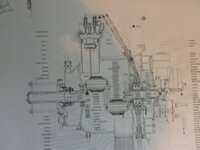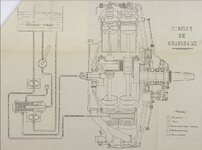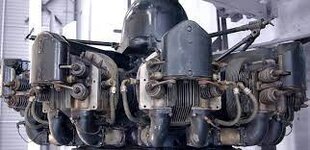loftonhenderson
Recruit
- 5
- Sep 3, 2023
I'm considering Kaiserreich-esque Alt Hist timeline where Canada + a bunch of British exile engineers have to build aero engines -- for speed of development, reliability, and simplicity they just develop the Bristol Mercury/Pegasus, avoid sleeve valves and stick with poppet valves, and also go back to 2-valves per cylinder. I'm mainly interested in what those hypothetical radial engines look like (as specifically as possible) assuming further development of the Mercury and Pegasus past their OTL capabilities.
I've scoured the web for AH engine development threads and what seems to keep coming up in posts by people with far more expertise than I'll ever have is:
Beyond all the unknown unknowns, I could really use some help filling in the "?" specs listed below (hoping for reasonable displacement, HP, diameter, and bore x stroke estimates for each). Additionally:
ALT Bristol Mercury
Mercury (OTL 9-cylinder redesigned with 2-valves per cylinder)
24.9L
900+ HP (995 HP on 100 oct fuel)
51.5" diameter
5.75" x 6.5" bore and stroke
Mercury (14-cylinder)
38.7L or 38.9L
1400-1600 HP
51.5" diameter
? bore and stroke
Alternative to Hercules
*Twin Mercury (18-cylinder)
50L or 49.2L
~1800-2100 HP (1800+ HP on 87 oct, 1900 HP on early 100 oct fuel, 2000+ HP should be available in low S/C gear)
? diameter (since it's twinned, diameter would be the same as a single Mercury right?)
? bore and stroke
*Mercury (14-cylinder with stroke reduced to 5" or 5.5")
(with a 5.5" stroke the cylinder dimensions and displacement are identical to the R-2000 Twin Wasp)
29.5-32.8L
? HP
? diameter
? x 5" or 5.5" bore and stroke
Alternative to Taurus but lighter and with slightly more power
*Mercury (10-cylinder)
???
ALT Bristol Pegasus
Pegasus (OTL 9 cylinder redesigned with 2-valves per cylinder)
28.7L
1100 HP max
55.3" diameter
5.75" x 7.5" bore and stroke
Twin Pegasus (18-cylinder)
2000-2200+ HP (other estimate are ">2000 HP" and "1,800-2,000 HP with more in later versions")
? diameter (since it's twinned, diameter would be the same as a single Pegasus right?)
? bore and stroke
Alternative to Centaurus
flying by 1939 or earlier
*Pegasus (9-cylinder over-bored by 1/10")
? liters
1000-1100 HP on 87 oct, 1200-1300 HP on early 100 oct fuel
? diameter (expect slight increase in diameter over normal-bore Pegasus)
? bore and stroke (bore would be 1/10" increased presumably?)
Cheers all!
Lofton
I've scoured the web for AH engine development threads and what seems to keep coming up in posts by people with far more expertise than I'll ever have is:
- The 9-cylinder Mercury tops out at a bit less than 1000 HP
- The 9-cylinder Pegasus tops out around 1100 HP
- "Twinning" those engines offers a lot of additional potential for development -- most seem to think a 14-cylinder Mercury and 18-cylinder "Twin Pegasus" hold the most promise
- There are some other ideas about an 18-cylinder Twin Mercury, a 10-cylinder Mercury, and an over-bored 9-cylinder Pegasus (asterisk because they weren't the prevailing ideas)
Beyond all the unknown unknowns, I could really use some help filling in the "?" specs listed below (hoping for reasonable displacement, HP, diameter, and bore x stroke estimates for each). Additionally:
- Would a Pegasus or Twin Pegasus be too big for most fighters, especially '30s fighters?
- What is the benefit of a Twin Pegasus over a Twin Mercury (or vice versa)?
- How would 2-valves per cylinder instead of 4 affect things? Would that change specs like diameter...etc.? Would sticking to 4vpc actually be better?
- What are the benefits of a reduced stroke Mercury or over-bored Pegasus? How does that work in practice?
ALT Bristol Mercury
Mercury (OTL 9-cylinder redesigned with 2-valves per cylinder)
24.9L
900+ HP (995 HP on 100 oct fuel)
51.5" diameter
5.75" x 6.5" bore and stroke
Mercury (14-cylinder)
38.7L or 38.9L
1400-1600 HP
51.5" diameter
? bore and stroke
Alternative to Hercules
*Twin Mercury (18-cylinder)
50L or 49.2L
~1800-2100 HP (1800+ HP on 87 oct, 1900 HP on early 100 oct fuel, 2000+ HP should be available in low S/C gear)
? diameter (since it's twinned, diameter would be the same as a single Mercury right?)
? bore and stroke
*Mercury (14-cylinder with stroke reduced to 5" or 5.5")
(with a 5.5" stroke the cylinder dimensions and displacement are identical to the R-2000 Twin Wasp)
29.5-32.8L
? HP
? diameter
? x 5" or 5.5" bore and stroke
Alternative to Taurus but lighter and with slightly more power
*Mercury (10-cylinder)
???
ALT Bristol Pegasus
Pegasus (OTL 9 cylinder redesigned with 2-valves per cylinder)
28.7L
1100 HP max
55.3" diameter
5.75" x 7.5" bore and stroke
Twin Pegasus (18-cylinder)
2000-2200+ HP (other estimate are ">2000 HP" and "1,800-2,000 HP with more in later versions")
? diameter (since it's twinned, diameter would be the same as a single Pegasus right?)
? bore and stroke
Alternative to Centaurus
flying by 1939 or earlier
*Pegasus (9-cylinder over-bored by 1/10")
? liters
1000-1100 HP on 87 oct, 1200-1300 HP on early 100 oct fuel
? diameter (expect slight increase in diameter over normal-bore Pegasus)
? bore and stroke (bore would be 1/10" increased presumably?)
Cheers all!
Lofton




